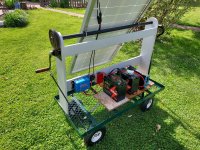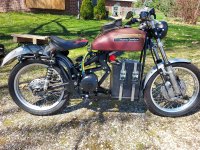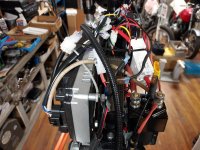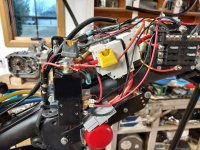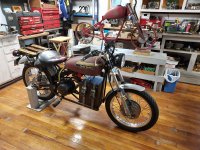Tfisher309
10 mW
- Joined
- Jul 3, 2022
- Messages
- 32
Having just pulled my battery for winter storage. It is a good time to share the experience I had with my electric motorcycle. First I would like to thank all the people who provide content on this forum. I could not have built the bike without your information.
The bike is a 1967 H-D Sprint with a qsmotor 138 70H V3, an EM-150 controller and a 74v 50ah battery. I built the bike last winter and road it about a thousand miles this summer. The bike is a joy to ride. Acceleration is strong up to 55 mph and it gets about 15 miles per kwh.
Something I wasn't ready for is the attention it gets. On the very first trip into town I came out of a grocery store and there was a small crowd around bike. This continued the rest of the summer.
To supplement the project and my electrical education, I constructed a home charging station. This solar cart provided 100% of the electricity the bike used this year. For the winter, the two batteries and inverter come inside and serve as emergency electrical backup for my house.
Thanks again. Tom
The bike is a 1967 H-D Sprint with a qsmotor 138 70H V3, an EM-150 controller and a 74v 50ah battery. I built the bike last winter and road it about a thousand miles this summer. The bike is a joy to ride. Acceleration is strong up to 55 mph and it gets about 15 miles per kwh.
Something I wasn't ready for is the attention it gets. On the very first trip into town I came out of a grocery store and there was a small crowd around bike. This continued the rest of the summer.
To supplement the project and my electrical education, I constructed a home charging station. This solar cart provided 100% of the electricity the bike used this year. For the winter, the two batteries and inverter come inside and serve as emergency electrical backup for my house.
Thanks again. Tom


